Flutter By
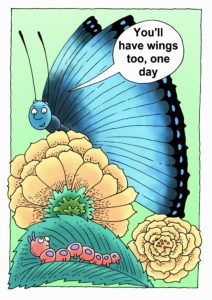
Do you ever like to catch bugs, butterflies, or other little creatures outside? Sometimes, you can catch bugs and watch them live in a jar for a while. Some of the most exciting bugs I remember chasing around the back yard were butterflies. There was something mysterious and extra special about these thin, colorful bugs that never went where I wanted them to go. Chasing butterflies always made me laugh. Just when I thought I nearly caught one, the butterfly would suddenly turn or switch directions, fluttering above my head. Have you ever tried to chase a butterfly?
Butterflies
Butterflies have long, thin bodies, made of three sections, just like other insects. They have compound bug eyes made up of many different lenses. Our eyes each have a single lens, but butterflies and other bugs have thousands of tiny lenses clustered together in each eye. This gives a creature special abilities to see around itself and get a better picture of the outside world. Butterflies feed on flower nectar by using a proboscis (say it: “praw-boss-cuss”)– a long, super thin touge-like part of their body that can curl and suck up nectar, almost like a straw. Of course, wings are usually the most beautiful part of a butterfly (and give it the ability to fly). Wings come in many different colors, patterns, shapes, and sizes.
Worm Work
Have you ever read the short picture book, “The Very Hungry Caterpillar”? Just like the little caterpillar in this book eats and eats until it is ready to be transformed into a butterfly, real caterpillars have a very healthy appetite. They don’t eat junk-food, like the caterpillar in the book, but are very picky eaters. Caterpillars from different types of butterflies only eat leaves from their specific types of plants. Caterpillars of Monarch butterflies only eat milkweed plants. A mother butterfly lays her caterpillar eggs on just the right type of leaf. After the egg hatches, the caterpillar eats its egg shell and the leaf the egg was on and continues eating and growing. Caterpillars must shed their outer skin several times because they outgrow their outer skeletons (like a snake sheds). The last time it’s ready to shed, the caterpillar does something very different . . .
After hatching, some caterpillars grow more than 3,000 times their size. This would be like a six-pound newborn human baby eating enough to weigh more than two African elephants together!
Remodeling
The last time a caterpillar sheds, it doesn’t have a new skeleton underneath, but develops a chrysalis instead. While hanging upside-down on a nice branch, the caterpillar creates this nearly cone-shaped wrapping. The outside of a chysalis has a special pattern of dots. On the outside of its bright green chrysalis, a monarch butterfly has twenty-four gold specks around its heart, and twelve more gold specks marking other important body parts. Many critical body parts that the creature could not live without (including the stomach) are completely dissolved and re-made during this process of metamorphosis (pronounced “met-a-more-fa-sis”). Whole body systems are remodeled, changing the way the creature eats, moves, senses, and more.
A butterfly transforms in a chrysalis (say it: “Kris-a-lis”) that hangs from something, while a moth uses a cocoon that hides instead of hangs. You can call either one a “pupa” (say it: “Pew-puh”) while it is transforming
Totally New Life
After going through metamorphosis, the fluttering butterfly is ready for a totally different life than it used to have as a caterpillar. Those short, stubby caterpillar legs turn into very long and thin butterfly legs. Its eyes transform into compound eyes, ready to help the butterfly see flowers. It uses its new proboscis to suck nectar from those flowers and get a nice meal. Instead of crawling on the ground and on leaves, the butterfly now has the amazing ability to fly. A transformation like this never could have come about by accidental evolution. Step by step – every part of the process of butterfly transformation had to be in place from the start.
Sometimes, the bright colors of butterfly wings can make them look poisonous to other creatures who might want to eat them
Big Blue

Colors like red, brown, orange, and some blacks in butterfly wings come from the scales actually being naturally “dyed”. Black and orange Monarch butterflies have these “dyed” scales. Colors like blue, green, white, and sometimes black are often iridescent. The color can look different as the butterfly moves its wings. They almost look like they’re glowing, like a computer screen. These colors are not made by the scales being dyed, but by the microscopic designs inside the scales that reflect and bend light. The way you can see these colors is a lot like the way you can see the colors of a rainbow through distant rain. Blue Morpho (say it: “more-fow”) butterflies have this special iridescent blue color on their wings, but only on the top of their wings. The bottom sides of their wings are brown and have shapes that help it to blend in with tree branches.
Moths
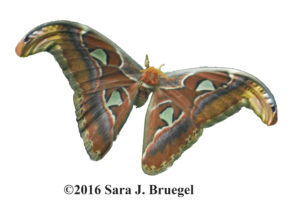
At first, moths look very similar to butterflies. The bodies of a moth are usually thicker and more “hairy” than butterflies. When moths rest, their wings are usually open or flat. Butterflies rest with their wings folded closed or slowly opening and closing. A moth’s antennae are usually shorter and hairier than those of a butterfly. While you might be tempted to think of moths as the “ugly” version of a butterfly, some moths are actually quite colorful. The Atlas Moth is very large and has some beautiful patterns on its wings
Monarch Relay
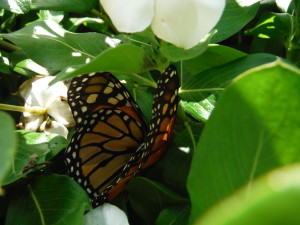
Have you ever tried a relay race? You run for a lap, then you stop and a friend continues running for you, then someone else takes over for them. Monarch butterflies have special orange and black patterns on their wings. This type of butterfly is an amazing traveler and survivor with a special family adventure story. Grandma monarch eggs usually hatch near Texas in the spring. They fly north a few states, following the spring warmth, then lay their eggs, and die. Mamma monarchs hatch from those eggs, enjoy their lives, and keep flying north until they find their southern home around the border between the United States and Canada where they lay their eggs. Baby Monarchs hatch from those eggs, and notice that it’s time to go south for the winter, so they begin the long journey, flying all the way to Mexico. While both Grandma and Mamma Monarch lived for only a few weeks and traveled a short distance, Baby Monarch lives for eight to nine months and flies about three thousand miles south. In a forest of special trees in the mountains of Mexico, monarch butterflies gather by the millions all clumping together on the trees to keep warm. Some don’t survive the winter, but the ones that do fly back to Texas in the spring, lay their eggs, and die. (Learn more about this incredible journey of the monarch by clicking here)
“Monarch” means royal. While changing from a caterpillar to a butterfly, they forma a special “crown” of golden dots on the outside of the chrysalis around the area where their head is developing
Butterfly
Looking at the lives of butterflies, and especially the traveling Monarch, we can see God’s extra special care for the creatures He made. He makes them beautiful and gives them special abilities. He perfectly planned their amazing transformation from caterpillars to butterflies. But, most butterflies only live for a few weeks. If our Creator put so much care and art into these butterflies, how much more does He care about you and carefully craft all the details of your life? He made you “in His image” – so much more special than any kind of animal. (To learn more about butterflies, click here)
NEW!
Printable Coloring Page – Click Here
For Your Information . . .
CCK is written by Sara J. Bruegel. Many thanks to Richard Gunther for the fun cartoon & coloring page. If you have a question or comment about God’s creation that you would like to share, please write to Sara at: CreationCluesForKids@gmail.com Also, you can visit www.CreationClues.com to learn more about our Creator’s amazing world of science, read a new article every week or read & print past issues of CCK. Please share CCK with your friends & family!
We encourage you to print as many copies as you like for yourself, friends, church, private school, ministry, or other groups, free of charge. All we ask is that you respect the author’s copyright by 1)giving full credit to the author, 2)DO NOT charge for this newsletter or in any way try to make money off of Creation Clues

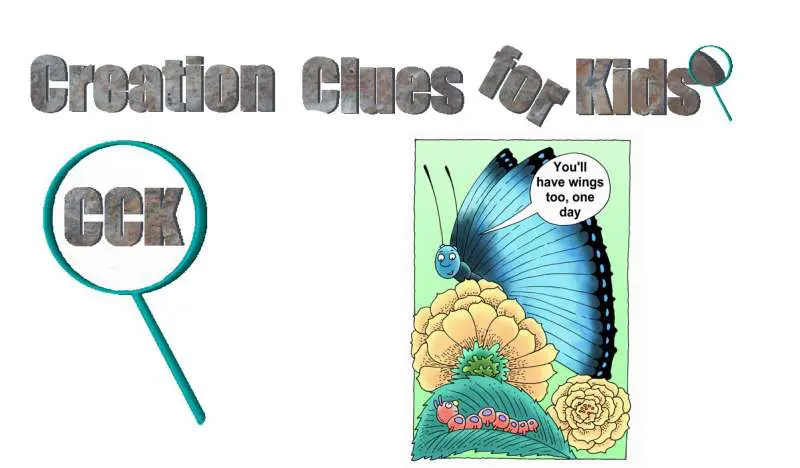



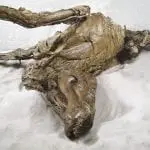
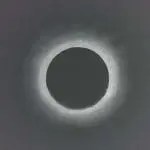
My favorite animal type.